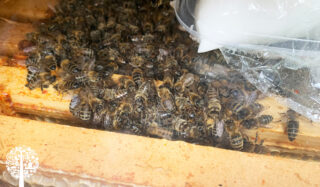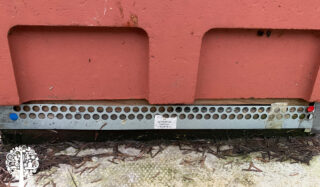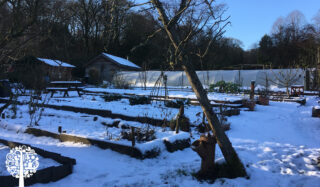Honeybees represent a small fraction of the world’s 20,000 bee species; they’re an incredible example of evolution. They undertake many jobs to survive and can adapt to many situations. They live in colonies of tens of thousands in peak summer, but during autumn, when the weather cools and pollen becomes less available, the numbers in the hive decline. Pollen, not temperature, regulates the bee’s survival and adaptation and initiates the winter bee’s development.

No Thanks To Rain
As a rule, bees do not like rain. Wet weather makes them grumpy and life difficult. Heavy rain can damage our furry, buzzy friends and is the enemy when harvesting nectar, diluting it in flowers and rendering it unusable for bees. Rain also makes transferring pollen to the hive and pollination virtually impossible.
So, on a rainy day, bees will hunker down and cuddle up in the hive. There is evidence to show bees can ‘predict’ the weather, or rather, their behavior indicates they are sensitive to changes in the weather. So, if rain is due, they will stay inside.

Bees seem ‘happier’ with cold, dry weather, frosts, and snow. As winter kicks in, the beekeepers who tend the Apiary at the community garden I manage in NW England visit every fortnight to check the beehives and their inhabitants.
Keep Out Predators
After a week of snow, ice, and sub-zero conditions, I was delighted to get a peek inside one of our six active beehives and see them all busying away. As natural food sources are hard to come by, beekeepers provide supplement food to keep the workers going and the queen bee content. It’s always a joy to see them moving around the hive; it’s a glimpse into another universe. The hives are open for a matter of seconds, enough time to ascertain their well-being. The beekeeper can tell by the hive’s weight if it is thriving.

I noticed the narrow metal strip dotted with small holes at the lower edge of the hives. A mouse guard – to prevent mice from getting in. Mice do not hibernate and can be troublesome in winter as they actively forage for food. If a mouse gets into a beehive, it will destroy everything – eating its way through entire frames filled with wax, nectar, pollen, and bee larvae. The honeybees clustering together to keep warm and protect the queen will not break away willingly. Any mouse that gains entry has free rein to wreak havoc and can destroy a colony in minutes.
A Different Kind Of Bee
The body of a honeybee adapts fascinatingly as winter approaches. Winter bees are referred to as ‘diutinus,’ meaning ‘long lived.’ They thermoregulate the winter cluster and rear small brood numbers to keep the colony ticking. Then, toward the end of autumn, as egg laying slows dramatically or stops entirely and pollen becomes scarce, winter worker bees emerge.
From early spring to autumn, regular adult bees live for up to six weeks, and the cycle of metamorphosis from egg to adult continues on a rolling basis. As the colder weather comes, the body of the emerging winter bee develops to contain a much higher concentration of vitellogenin, a protein that enhances immunity and increases lifespan.

Vitellogenin keeps the queen bee alive for many years. And winter bees are loaded with it, enabling them to survive for six months or more. With no nectar or pollen to collect, the winter bees slowly eat through their limited food supply and cluster to regulate the temperature in the hive. But somehow, they must prepare for the oncoming spring – pollen collection, drone rearing, and feeding the first spring brood. How they do this is a fantastic feat of nature.
Fabulous Fat Bodies
It all comes down to their body structure. Winter bees and summer bees look the same on the outside. Inside, the difference is astonishing. The abdomen of a summer bee is dark and watery, whereas inside a winter bee is a white, fluffy-looking substance – fat bodies. These fat bodies break down proteins, carbohydrates, and other nutrients into new chemicals. They produce the vitellogenin that guarantees the bees’ survival. Nectar supplies the sugar, and the pollen provides everything else – protein, fat, lipids, vitamins, minerals, and antioxidants. Winter bees have evolved so that the vital storage of proteins occurs within their bodies (as opposed to stocks kept within the frames of the hives), ensuring the colony’s survival into spring.
Watch Out On A Warm Day!
With the cold temperatures and likelihood of rain outside, the absence of nectar and pollen collection on the agenda, winter bees do not defecate inside the hive. Instead, they hold on to their feces, waiting for a dry, warmer day to get out for a ‘cleansing flight.’ Watch out when this happens! Beware of hanging out white bed linen on a relatively warm winter’s day if you’re anywhere near a beehive. Those tiny black dots you find splattered on your fresh laundry may be confused for soot from a bonfire. More likely, they’re the outcome of a colony of winter bees emerging for a good old gut clear-out!